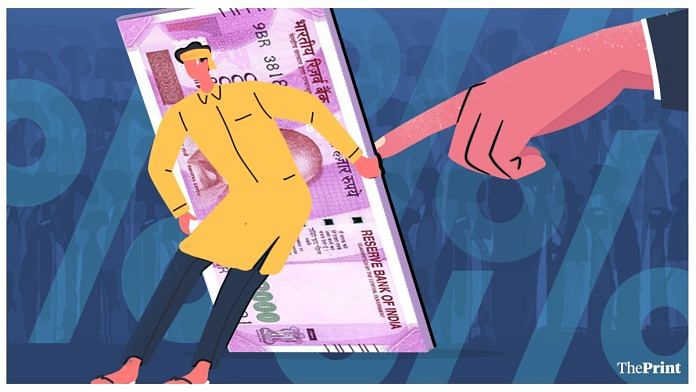New Delhi: Members of the Reserve Bank of India’s Monetary Policy Committee are not all that concerned that the liabilities of India’s households are increasing, or that their savings are falling. To the contrary, the minutes of their latest meeting show some members of the top interest rate-setting body feel that credit-based consumption might actually become a “self-fulfilling prophecy” that will propel economic growth.
Household liabilities or household debt includes the combined debt of all people in a household, including consumer debt and mortgage loans.
The issue of falling savings and rising household liabilities has generated considerable debate over the last few months. Some commentators — such as former Prime Minister’s Economic Advisory Council member and former RBI Governor C. Rangarajan — said that a persistent fall in household financial savings is something policymakers should not ignore.
Other commentators, such as Axis Bank economist Saugata Bhattacharya, say that falling household savings would mean that investments would increasingly be dependent on foreign capital.
For its part, the Ministry of Finance waded into the debate with a post on X (formerly Twitter), saying that falling savings were not a concern because they were offset by households increasingly taking loans to invest in assets, which was a reflection of their confidence in future employment and sources of income.
Now, the views of the members of the Monetary Policy Committee (MPC) have been made public.
The MPC met on 4-6 October, following which RBI Governor Shaktikanta Das conveyed the committee’s unanimous decision to keep the benchmark interest rate unchanged at 6.5 percent. The central bank Friday released the minutes of that meeting, revealing insights into the discussion the members had regarding the state of the economy.
Of the six members of the MPC, three made particular mention of the decline in household savings and the increase in households’ liabilities, apart from touching upon the more common topics such as global growth, domestic demand, inflation levels, and the overall state of the economy.
“It was household financial liabilities that increased from 3.8 percent of GDP in 2021-22 to 5.8 percent of GDP in 2022-23, by a similar 2.1 percent fall in net financial savings (sic),” Ashima Goyal, a member of the MPC said, according to the minutes of the meeting.
Goyal said the rise in households’ financial liabilities — which means they were taking more loans — implies an increase in the investment these households are making in acquiring assets.
Jayant R. Varma, another member of the MPC, said that the data available shows that consumers are taking loans and are reducing their financial savings, and are instead using those funds for consumption — something he said was an important development for the economy.
“This willingness to consume at the cost of reducing savings is very important because it is household consumption that has been propping up the economy in the face of headwinds from fiscal consolidation, weak external demand, and tepid capital investment,” Varma said, according to the minutes.
Also Read: Households are saving less and borrowing more, but that’s not necessarily a bad thing
‘Robust consumption demand stimulates growth’
Notably, Varma said that the debt-fuelled consumer sentiment could reinforce itself over time, becoming a “self-fulfilling prophecy” as “robust consumption demand stimulates growth, generates income, and strengthens household balance sheets”.
Further, he said that even if this does not come to pass, global experience in the past has shown that a debt-fuelled consumption boom can take several years before waning.
“Either way, the medium-term growth outlook looks somewhat stronger than it did during the last meeting, though several headwinds still remain,” he added.
This was a sentiment largely echoed by a third member, Rajiv Ranjan. He said that the pattern of household borrowings implied higher spending on real estate, vehicles, consumer goods, and other items of consumption, which would help to boost economic growth.
“This implies that the overall savings of households are expected to hold steady with a compositional shift in favour of physical savings (versus financial savings),” Ranjan said. “This would be growth supportive either through direct addition to gross capital formation or by assisting upturn in private capex.”
Goyal, however, did sound a note of caution as well, saying that while Indian household debt was low as compared to international standards, a sudden jump could cause problems.
“It is best to restrain over-enthusiasm in good times and thus avoid a crash,” she said.
Also Read: Why Indians are racking up huge credit card bills — stagnant or shrinking incomes, higher spending



